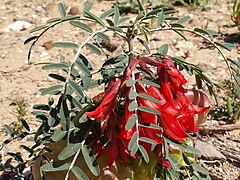Lessertia frutescens
| Habit | shrub
| |
|---|---|---|
| Height: | ⇕ | 5 ft"ft" can not be assigned to a declared number type with value 5. |
| Width: | ⇔ | 5 ft"ft" can not be assigned to a declared number type with value 5. |
| Lifespan: | ⌛ | perennial |
| Bloom: | ❀ | early winter, mid winter, late winter |
| Exposure: | ☼ | sun |
|---|---|---|
| Features: | ✓ | flowers, naturalizes, foliage |
| USDA Zones: | 9 to 11 | |
| Flower features: | ❀ | red, orange, yellow, pink |
Sutherlandia frutescens (Cancer bush, Balloon pea, Sutherlandia; syn. Colutea frutescens L., Lessertia frutescens (L.) Goldblatt & J.C.Manning) is a southern African legume which is reported to be effective in treating HIV/AIDS. It is a shrub with bitter, aromatic leaves used to treat cancer. Currently in clinical trials for cancer and AIDS. Infusion made from the leaves is a traditional remedy for fever, chicken pox, flu, rheumatism, hemorrhoids, diarrhea, and stomach and liver problems. Also makes an excellent wash for wounds. Red-orange flowers appear in spring.
Sutherlandia frutescens is a much-respected and long-used medicinal plant that is also an attractive garden plant, and has been cultivated in gardens for many years, for its fine form, striking colour and luminous flowers.
Sutherlandia is an attractive small, soft wooded shrublet, 0.5 to 1 m in height. The leaves are pinnately compound . The leaflets are 4–10 mm long, grey-green in colour, giving the bush a silvery appearance. They have a very bitter taste.
The flowers are orange-red, up to 35 mm long, and are carried in short racemes in the leaf axils at the tips of the branches in spring to mid-summer (September - December).The flowers are not typical 'pea' flowers, the wing petals are very small and are concealed in the calyx, and the standard petal is much shorter than the keel.
The fruit is a large, bladder-like, papery inflated pod and is almost transparent. It can be used in dry flower arrangements as it dries well, maintaining its colour and form.
Sunbirds pollinate the attractive, butterfly-like red flowers. The lightweight, papery, inflated pods enable the seed to be dispersed easily by wind.
Sutherlandia frutescens occurs naturally throughout the dry parts of southern Africa. It shows remarkable variation within its distribution.
Read about Lessertia frutescens in the Standard Cyclopedia of Horticulture
|
|---|
|
Sutherlandia frutescens, R. Br. Shrub, about 3 ft. high: lvs. with 9-11 pairs of lfts. and an odd one: fls. drooping and in the best variety 1 in. or more long, not pea-shaped: pod sometimes 2 1/4 x 1 1/4 in., bladder-like. S. Afr.
|
Cultivation
Sutherlandia is fast growing and easy to grow, but short-lived as a garden subject. It is a tough, hardy plant that does well in full sun and tolerates all soil types. It occurs both in summer and winter rainfall regions, and is quite drought tolerant so does not require much watering. When growing it in containers, make sure that it is well drained and don't over-water. The plant is also quite pest resistant. Plants seed themselves readily, so that as the older plants start to look past their best they can be removed.
It makes interesting temporary filler in the mixed border, rockery or shrubbery, especially if it is planted in groups or en masse. It is also a good contrast foliage plant against a green backdrop and can be used effectively to punctuate a soft landscape planting. It is also a must for the herb garden. It grows well in containers, and can be used as a temporary decoration for the patio or courtyard. Because they are fast and tough, they also work quite well as pioneers in a new garden, where they give cover and colour while the slower growing perennials get going.
The cancer bush seeds itself readily, and grows easily from seed. Sow in autumn or spring in well-drained soil. Germination is improved if seeds are left to soak for about 4 hours or overnight in water hot enough for you to put your hand in. We have found that many members of the pea & bean family are susceptible to pre-emergence damping off. Using sterile soil and treating the seed with the Apron (a.i. metalaxyl) effectively combats fungal infection. Keep the seed trays warm (not hot) and damp but not wet. Germination should occur in 2 to 3 weeks and seedlings can be transplanted as soon as they are large enough to handle. Planting the plants close together in groups of 3 or 5 will give you a fuller, more attractive bush.
Propagation
Pests and diseases
Varieties
Gallery
References
External links
- w:Lessertia frutescens. Some of the material on this page may be from Wikipedia, under the Creative Commons license.
- Lessertia frutescens QR Code (Size 50, 100, 200, 500)

